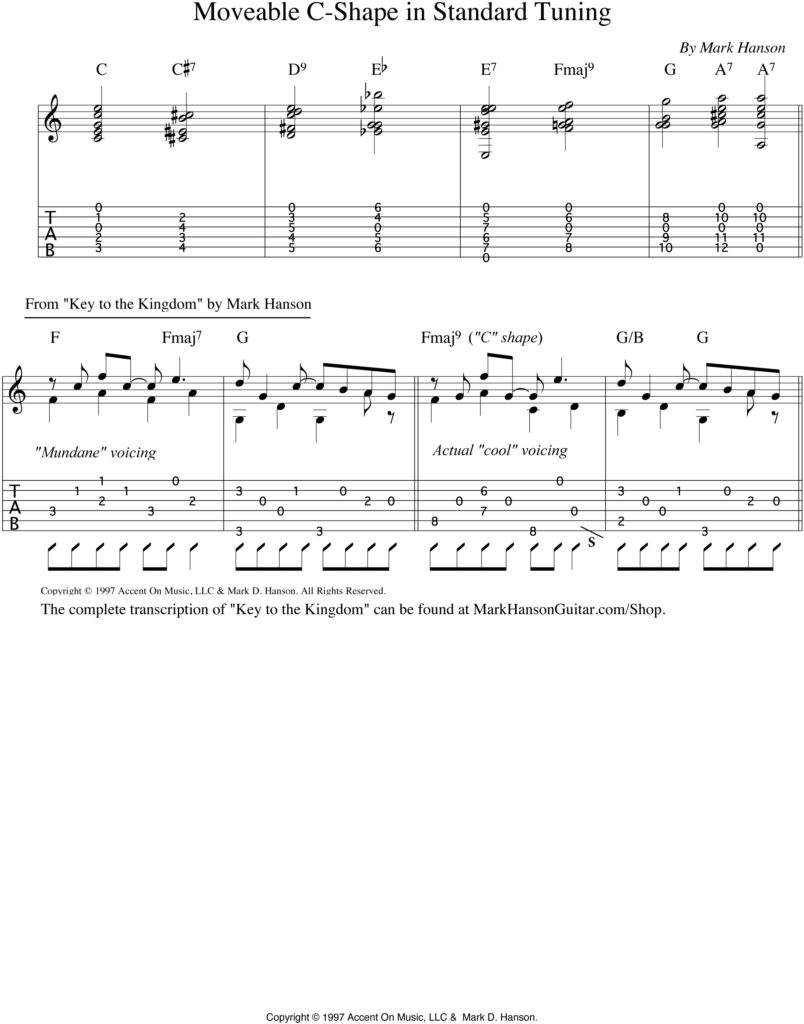By Mark Hanson
May, 2020
For fingerstyle guitar one of my favorite chord shapes in standard tuning is “C”. (Actually, I appreciate ALL the shapes!) The reason I like “C”: In the lower voices I sustain the root note and third (the two notes that largely define a major or minor chord) with my ring and middle fingers, leaving my “outside” fingers, the little and index, free to fret moving melody notes anywhere in the treble range.
I first learned about moving the C shape long ago in Paul Simon’s “Kathy’s Song” and Peter, Paul & Mary’s “Great Mandela.” In the key of G, Simon moved the C shape up two frets to create a lovely, complex D chord, with the open G and high-E strings ringing in conjunction with the fretted strings. PP&M added the little finger to the shape (C7) and moved it to the 5th/6th/7th frets to produce an E7 chord. (Move this shape to the four treble strings at 5/6/7 and you have the song’s opening A6 chord.)
You can use this C shape all the way up the neck. Here are fret positions of the bass note on the fifth string of a C shape, and the chords that result:
C—3rd; C#7—4th; D—5th; E-flat—6th; E—7th; F—8th; G—10th; A (A7)— 12th.

Just slide your C shape up the neck to each of these positions, pick the strings individually, and see what happens!
Be careful when strumming these chords: the open strings may sound great picked individually amongst the regular fretted chord tones, but may sound dense and dissonant when strummed simultaneously. Also, adding a finger to the shape may alleviate some dissonance: For example, add the little finger on the first string/6th fret for E-flat (and avoid the bass string); and add the little finger on the third string for E (E7). You may include all six strings on E7.
Ragtime players long have used the C shape up two frets, adding the little finger on the third string to make it a D7. I use a C#7 in both my “You Don’t Know Me” and “In the Summertime” arrangements—the C7 shape raised just one fret.
I also use the C-shape very effectively as an F chord in my tune “Key to the Kingdom.” The accompanying notation/tablature shows a simple descending scale on top of an F-G chord progression. First I play it the mundane way in the first position — nice, but boring. Then I play the same melody over an F chord played as a C-shape at the 6/7/8 frets. With the open strings ringing it creates a wonderful cascade of notes. Very effective!
You can watch “Key to the Kingdom” here, and buy the notation/TAB/explanation here.
“You Don’t Know Me” is here to hear, and here for the notation/TAB. My arrangement of Mungo Jerry’s “In The Summertime” is included here.


3 thoughts on “Successfully Move a “C”-Shape Up the Neck!”
Hi Mark,
What would be a C/G chord shape played on the 6th (060788)? A bit different from Fmaj9?
Thanks!
Thanks, N. Yes, it would be an Fmaj9/C, with the 9th — the G note — included in the middle of the voicing.
The only time I would fret this chord as you describe would be for strumming. If I were fingerpicking this chord I would fret the fifth snd sixth strings one at a time with the ring finger as I pick them. That leaves my little finger available to fret treble notes that I might want to include.
Thanks for this great article. I very often play the C shape in 5th fret as a variation to the normal D chord – it is so simple to just move from C to D in that way. I have tried to find the right way to put it on paper when I share sheet music with others, but have not found the actual right name for the chord, so I just put D and then a note that it should be played as a C chord in 5th fret. Any suggestions on that?
I will definitely experiment moving my C shape further down the neck.
Thanks!